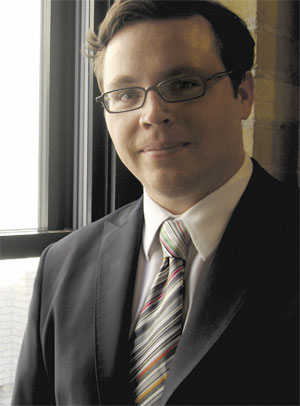 |
| Dal law grad David Steeves won an essay competition for his paper re-examining a 1933 double murder case. |
In the summer of 1933, Halifax was rocked by a horrible tragedy. The bodies of two brothers, Edward and Bramwell Heffernan, were found a short distance from each other along the railway tracks that ran near their home, located on the outskirts of Halifax near the present-day Armdale Rotary.
With their clothes torn to shreds and their bodies battered and bloodied, many people believed there was one of two possible explanations for the boys’ deaths: either they had been hit by a passing train or had fell into the hands of a deranged killer.
‚ÄúThere was huge pressure on the police department to find somebody and at the end of the day they did find somebody,‚ÄĚ says Ľ∆…ę÷Ī≤• Law School grad David Steeves, who became fascinated by the mysterious case and delved into it while taking the course Canadian Legal History taught by Prof. Blake Brown.
In December of 1933, police arrested Daniel Perry Sampson for the murders of the boys. A mentally challenged man who lived with his mother on Market Street, Sampson was a familiar face to one of the investigating officers. Put in a police line-up before two supposed eye witnesses, Sampson‚ÄĒthe only black man in the line-up‚ÄĒwas fingered as the perpetrator.
‚ÄúThe trial is where things get really interesting,‚ÄĚ says Mr. Steeves, 33. Irregularities include a signed confession‚ÄĒeven though Sampson couldn‚Äôt read and write‚ÄĒand the fact that the confession later went missing.
Sampson went through two trials and two appeals, including an appearance before the Supreme Court of Canada, before he was executed in 1935.
Mr. Steeves‚Äôs paper on the historic case won him the inaugural Race and the Law Essay Prize created by the Race Relations Committee of the Nova Scotia Barristers‚Äô Society and sponsored by law firm Stewart McKelvey. Now a lawyer and member of the Bars of Nova Scotia and Alberta, Mr. Steeves graduated this spring from Ľ∆…ę÷Ī≤• Law School with a Master of Laws degree. He also holds a Bachelor of Laws degree from Dal and a Bachelor of Arts degree in English literature and history from Mount Allison University.
‚Äú(Sampson) may have done it or he may not have,‚ÄĚ says Mr. Steeves, now based in Toronto. ‚ÄúWhat I was really focusing on were the significant concerns about how African Nova Scotians were treated in the courts, regardless of their guilt or innocence.‚ÄĚ
In his paper, Mr. Steeves comes to a startling conclusion about fairness in the Halifax courts between the wars, but wants to save his bombshell for the paper’s publication in the first collection of African-Canadian legal history forthcoming in 2010 and published by the Osgoode Society for Canadian Legal History.
As someone just starting out in practise, he says researching and writing the paper has given him an ‚Äúawareness of race that I‚Äôll always carry with me.‚ÄĚ
